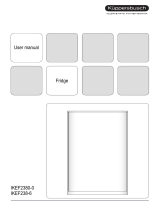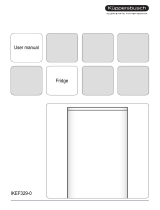
u
Press ON.
w
SabbathMode is switched on. Only the SabbathMode
symbol appears on the screen.
SabbathMode switches off automatically after 120 hours if
it has not already been switched off manually. The display
switches to the home screen.
5.3.2 Switch off the SabbathMode
u
Touch the screen.
u
Press OFF.
w
SabbathMode is switched off.
5.4 Refrigerator compartment
The natural circulation of air in the refrigerator compartment
results in zones differing in temperature. It is coldest directly
above the plate separating off the BioFresh zone and at the
rear wall. It is warmest at the top front of the compartment and
in the door.
5.4.1 Refrigerating food
Note
The energy consumption increases and the cooling perform-
ance decreases if the ventilation is inadequate.
u
Always keep the air slits of the fan free.
u
Place butter and preserves in the top area and in the door.
(see 1 Appliance at a glance)
u
Use reuseable plastic, metal, aluminium, glass containers
and foil wrap to store food.
u
Always store raw meat and fish in clean, sealed containers
on the bottom shelf of the refrigerator, to prevent them
coming into contact with or dripping onto other foods.
u
Foods that easily absorb or give off smell or taste, as well as
liquids, should be stored in sealed containers or covered.
u
Use the front area of the base shelf only to temporarily set
down refrigerated foods, for example while rearranging or
sorting the contents. Remember not to leave refrigerated
foods here as they could shift to the back or tip over when
you close the door.
u
Do not pack foods too closely together, as the air needs to
circulate.
5.4.2 Setting the temperature
The temperature depends on the following factors:
-
the frequency of opening the door
-
how long the door is open for
-
the room temperature of the installation location
-
the type, temperature and quantity of the food
The temperature can be set from 9 °C to 3 °C.
Recommended temperature setting: 5 °C
u
Press the fridge compartment field.
w
The following screen is displayed:
Fig. 38
Setting a higher temperature:
u
Press plus.
Setting a lower temperature:
u
Press minus.
The minus symbol is greyed out when the coldest temperature
is selected.
The plus symbol is greyed out if it is pressed again after
selecting the hottest temperature. The standby symbol is
displayed on the screen.
u
Confirm the required temperature with OK.
w
The display switches to the home screen.
w
The selected temperature is displayed.
w
Up or down arrows indicate the change in temperature.
The arrows are greyed out when the target temperature is
reached.
5.4.3 SuperCool
With SuperCool you switch to the highest
cooling performance to reach lower cooling
temperatures. Use SuperCool, to rapidly cool
large amounts of food.
When SuperCool is activated, the fan* may run. The appliance
operates with maximum cooling performance, which means
that the noise of the refrigeration unit may be temporarily
louder.
The SuperCool function uses slightly more energy.
Switching on SuperCool
u
Press menu.
u
Press the navigation arrow until SuperCool is
displayed.
u
Press the SuperCool symbol.
w
The following screen is displayed:
Fig. 39
The running time can be set to four levels.
Setting the running time:
u
Press plus or minus.
The minus symbol is greyed out when the lowest level is
selected.
The plus symbol is greyed out when the highest level is
selected.
u
Confirm the required running time with START.
w
The display switches to the home screen.
w
SuperCool is selected.
w
The remaining running time and the SuperCool
symbol are displayed in the fridge compartment field.
w
The lowered temperature is shown by the down
arrows.
w
After the remaining running time has elapsed the
appliance returns to normal mode. The temperature
is set to the preset value again. Up arrows show the
temperature increase.
Switching SuperCool off ahead of schedule
u
Press menu.
u
Press the navigation arrow until SuperCool and the
remaining running time are displayed.
u
Press on the remaining running time.
u
Press STOP.
w
SuperCool is switched off.
w
The temperature is set to the preset value again. Up arrows
show the temperature increase.
Control
* Depending on model and options 17





















